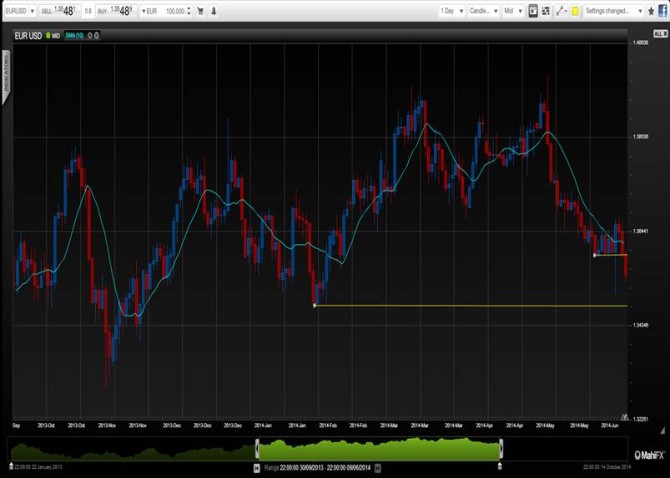So far the European Central Bank’s radical measures, which included negative deposit rates for commercial banks parking their money with it have done wonders to weaken the EUR. But unless more action follows through relatively soon the trend could be gradually reversed.
Fortunately for ECB President Mario Draghi, the US Federal Reserve is in the process of tapering its quantitative easing programme. The next logical step once that’s done is probably to start raising US interest rates, which will favour a stronger EUR/USD with the Eurozone still in easing mode.
But with the US economy hardly firing on all cylinders firmer US interest rates are not a forgone conclusion once QE ends. Therefore the ECB may need to do more if wants to keep the EUR low for the long-term.
By Justin Pugsley, Markets Analyst MahiFX. Follow @MahiFX on twitter
Ironically by creating a negative deposit rate for commercial banks it is also directing money into Eurozone bond and equity markets. This is creating a trend, which is attracting foreign speculators and hence places upward pressure on the EUR. Also, the Eurozone enjoys a large current account surplus with the rest of the world.
Low volatility environment favours EUR carry trade-based weakness
Make EUR the funding currency of choice
In some respects the ECB may have a bigger fight on its hands in its bid for a sustainably weaker currency than say Japan. Though Japan runs current account surpluses, it has a large trade deficit. Yet getting the USD/JPY above 100 took very deliberate and significant intervention from the Bank of Japan in the shape of its massive quantitative easing programme.
The determination of the Bank of Japan and also historical reasons made JPY the funding currency of choice for the carry trade – that is speculators sell low yielding JPY to buy higher yielding currencies.
One way the ECB could keep downward pressure on the EUR is to basically assure traders that the EUR is also a good long-term funding currency. That means doing what’s necessary to keep the EUR weak. This strategy should work well in the current low volatility environment as speculators are once again flocking towards higher yielding emerging market currencies for their higher yields.
Of course any spike in volatility would see a rush of short covering, but so far so good.
Draghi’s recent utterances for a lower EUR have been backed up by action. For a while at least the currency markets will be cautious about buying the EUR. But in the end actions have to back words in which case the next step would likely be quantitative easing.
For the time being that looks some way off – possibly until an asset backed market or some proxy of it once again flourishes in Europe. This would enable the central bank’s money to go more directly to businesses and households rather than bond and equity markets, which is exactly what Draghi wants.
Further reading: Is the Eurozone Crisis Really Over?

